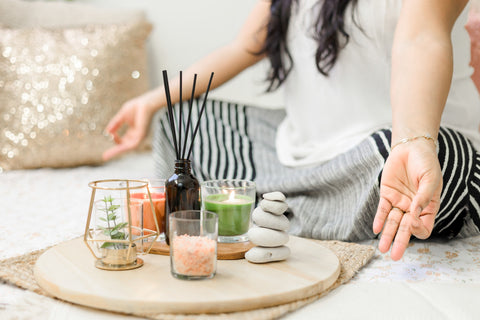If you’re wondering how to create a meditation space at home, the good news is that you don’t need much.
Technically, you could just sit on the floor or in a comfy chair, close your eyes, and zone out -- it’s really that simple.
However, you may find that doing the bare minimum isn’t as rewarding as it could be. And without an inviting space, it may be harder to get motivated to meditate daily as a result.
Like having the right workout gear and equipment, it pays to pick up a few meditation space essentials. These key items will help you build a consistent practice, deepen your sessions, and encourage you to show up each day as excited as the last.

5 Essentials for a Great Meditation Space
Googling “meditation space ideas” can lead you down a rabbit hole of complex and expensive Pinterest-worthy ideas.
But the goal isn’t to create a show-off room; it’s to strengthen your practice or start one altogether.
So rather than getting overwhelmed and going over budget trying to mimic those picture-perfect spaces, stick to these essentials and build your space as your practice evolves over time:
1. A Dedicated Space to Zone Out and Turn Inward
While you could technically meditate wherever you want, it helps to carve out a dedicated space to do so.
This will help you separate your meditation time from your sink of dirty dishes or workspace of unanswered emails.
So find somewhere you can sit comfortably and quiet your mind.
You don’t need an entire room of your home. You can get started with a small corner by a bright, sunny window or a quiet, secluded area where you won’t be disturbed. If the weather’s nice, pick your favorite tree to sit under.
Try not to use this space for anything else but meditating. This dedicated area will become your personal retreat. Once you sit down, you’ll find it easier and quicker to get in the right headspace.
As you make this space more inviting, it may even pull you in to meditate more often.

2. A Comfy Meditation Pillow to Sit On
Since you’ll be sitting for anywhere from 10 minutes to hours in quiet contemplation, you’ll want something comfortable for support.
Try to avoid places that are too comfortable, such as your bed, sofa, or recliner. You don’t want to fall asleep; you want to be in a state of relaxed alertness.
A meditation pillow is your best bet here. They’re specifically designed for a cross-legged seated position.
However, a regular pillow, an oversized pillow, or a rolled-up blanket or towel make excellent stand-ins when you’re just starting out.
Make sure to place these under your bum in a way that both makes you comfortable and helps you sit up straight.
The more supported and comfortable you make this experience, the longer you’ll be able to sit and focus on your breathing.
3. Candles or Essential Oils to Set the Mood and Help You Focus
Learning how to create a meditation space also means learning how to set the mood for introspection. Candles and essential oils can help you do just that.
The flickering flame can help evoke a spiritual feeling. It also gives you something to stare at if you’re more distracted with your eyes closed. The fine mist streaming out of an essential oil diffuser works the same way.
You can also combine aromatherapy with your daily meditation practice. Fresh citrus scents can brighten your mood and energize your mind during an AM session, while lavender and ylang-ylang relax and calm after a stressful day.
When you take deep breaths in and out, think of these scents working their magic on your mood and thoughts throughout your practice.

4. A Way to Play Ambient Sounds or Guided Meditations
If you’re just beginning your practice, a Bluetooth speaker may not be one of your first meditation space ideas. But it can also help set the mood with the right sounds.
A calm, instrumental, spa-like soundtrack can quiet your mind, so it’s easier to focus. Music-streaming apps like Spotify have tons of these types of playlists.
Hearing sounds like the crashing of waves, a thunderstorm, or a crackling fire can drown out distracting noises like car alarms or kids playing outside. You can find these on sites dedicated to ambient sounds, such as A Soft Murmur.
New meditators may also find guided meditations especially helpful. With these, a seasoned meditation instructor will walk you through your practice with vocal cues and prompts to think about. You can find these on YouTube.
So put on your headphones or connect your phone to external speakers, and let these wash over you as you tune out and turn inward.
5. Photos and Objects that Help You Relax, Focus, and Find Comfort
Once you have those basic meditation space essentials, you may want to start customizing your space to make it more your own.
To create a warm, welcoming, personalized space to retreat, consider including:
- Photos of your friends and family to show you’re surrounded by love.
- Relaxing images like serene beach scenes, mountaintops, or forests, which may distance your thoughts from the present hustle and bustle.
- Travel memorabilia to help you disconnect from the daily grind and ignite that spark of (internal) exploration.
- Indoor plants to boost concentration, purify your air, and reduce stress.
- Spiritual decorations such as Buddha statues, mandala paintings, crystals, singing bowls, etc.
- A yoga mat so you can stretch out before and after your practice, unwind, and move energy within your body.
Many of these additions can serve as a focal point to stare at should you find closing your eyes too difficult during meditation.
Keep in mind, you don’t need these add-ons to have an amazing meditation space. Just showing up each day will get you closer to your goals.

Final Thoughts on These 5 Essentials for a Great Meditation Space
Instead of getting overwhelmed by those Instagram-worthy meditation spaces, start out with the bare essentials and expand as your practice deepens.
A dedicated space, a comfy pillow, and a few items to help you set the mood are all you need to start a daily meditation habit.
In the end, it doesn’t matter what you have. All that matters is that you’re able to zone out, turn inward, and enjoy all the benefits that come with meditating. That’s what really counts!
Author: Devan Ciccarelli
Email: devan@behappynothangry.com
Instagram/Facebook Group: @behappynothangry/Be Happy Not Hangry
Website: www.behappynothangry.com




